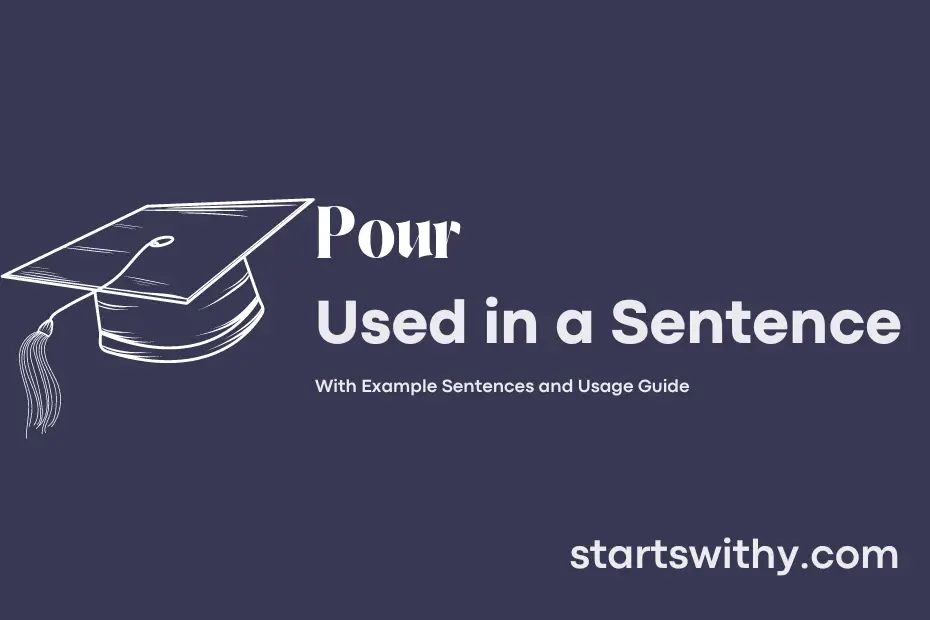Have you ever wondered how to properly use the word “pour” in a sentence? “Pour” is a versatile word that is commonly used in both cooking and everyday language to describe the action of transferring a liquid from one container to another in a steady stream.
Whether you are pouring milk into your morning coffee or pouring your heart out to a friend, knowing how to use “pour” correctly will help you effectively convey your intended message. Let’s explore the various ways this word can be used to add depth and clarity to your sentences.
7 Examples Of Pour Used In a Sentence For Kids
- Pour some milk into your cereal.
- Can you pour the water into the plants, please?
- Let’s pour some paint on the paper and make a pretty picture.
- I will pour some juice into your glass.
- Watch how the raindrops pour from the sky!
- Pour some sand into the bucket to build a sandcastle.
- Be careful not to pour too much glue on your project.
14 Sentences with Pour Examples
- Pour some milk into your cereal for a quick breakfast before class.
- Don’t forget to pour water into the coffee machine to make a fresh brew.
- Pour some dressing over your salad for a healthy lunch option.
- It’s important to pour the correct amount of chemicals in the lab experiments.
- Remember to pour yourself a glass of water to stay hydrated during lectures.
- Pour some sauce over your noodles for a delicious meal after a long study session.
- Make sure to pour detergent into the washing machine before doing your laundry.
- Don’t be afraid to pour your thoughts and opinions into your academic essays.
- Pour some oil into the pan before starting your cooking session.
- Pour some juice into a glass to enjoy a refreshing drink while studying.
- It’s always a good idea to pour some extra effort into your studies for better results.
- Pour some hot water into a cup to make a relaxing cup of tea after a stressful day.
- Pour some ink into your pen to continue taking notes in class.
- Make sure to pour some seasoning into your dish for added flavor.
How To Use Pour in Sentences?
Pour can be used as a verb in a sentence to describe the action of transferring a liquid from one container to another.
Here are some examples of how to use pour correctly in a sentence:
- “Please pour some water into the glass.”
- “She likes to pour milk into her cereal every morning.”
- “Don’t forget to pour the sauce over the pasta before serving.”
To use pour effectively in a sentence, it is important to identify the liquid being transferred and the destination of the liquid. Using pour adds clarity and precision to your statement.
Additionally, you can use pour in different tenses and with various subjects to fit the context of your sentence. For example, you can say:
- “He poured the juice into a pitcher.”
- “They will pour the batter into the cake pan.”
- “She is pouring the tea into a teapot.”
By practicing using pour in sentences, you will become more comfortable with incorporating it into your everyday language. Remember to pay attention to the details of the action, such as the direction and quantity of the liquid being poured, to ensure clear communication.
Conclusion
In conclusion, the sentences presented with the keyword “pour” demonstrate a variety of ways in which this word can be used to convey different meanings and contexts. From pouring a cup of coffee to pouring emotions out in a heartfelt conversation, this word showcases its versatility in the English language. Whether describing physical actions or emotional expressions, “pour” effectively communicates a sense of motion, release, or transfer in sentences.
The sentences using “pour” illustrate the importance of choosing the right words to accurately express ideas and emotions. By incorporating this versatile term into writing and speech, individuals can effectively convey both simple actions and complex feelings with clarity and precision.



